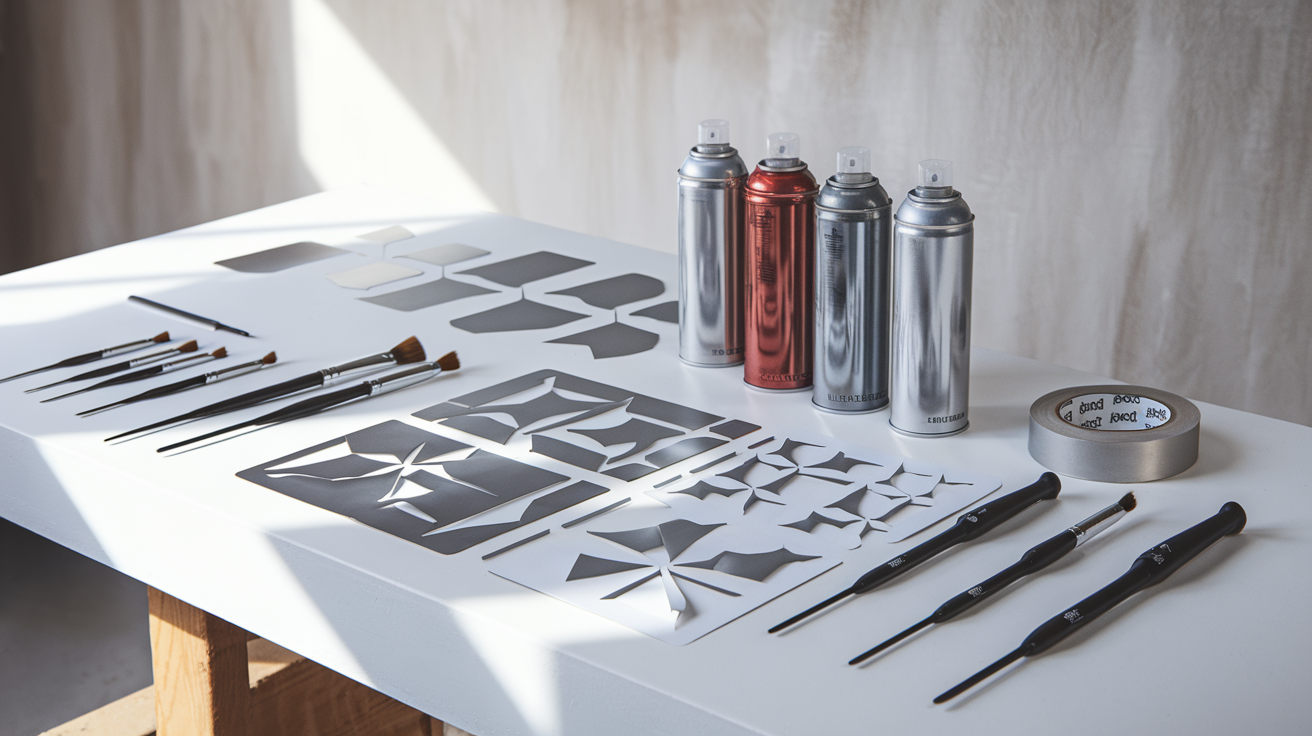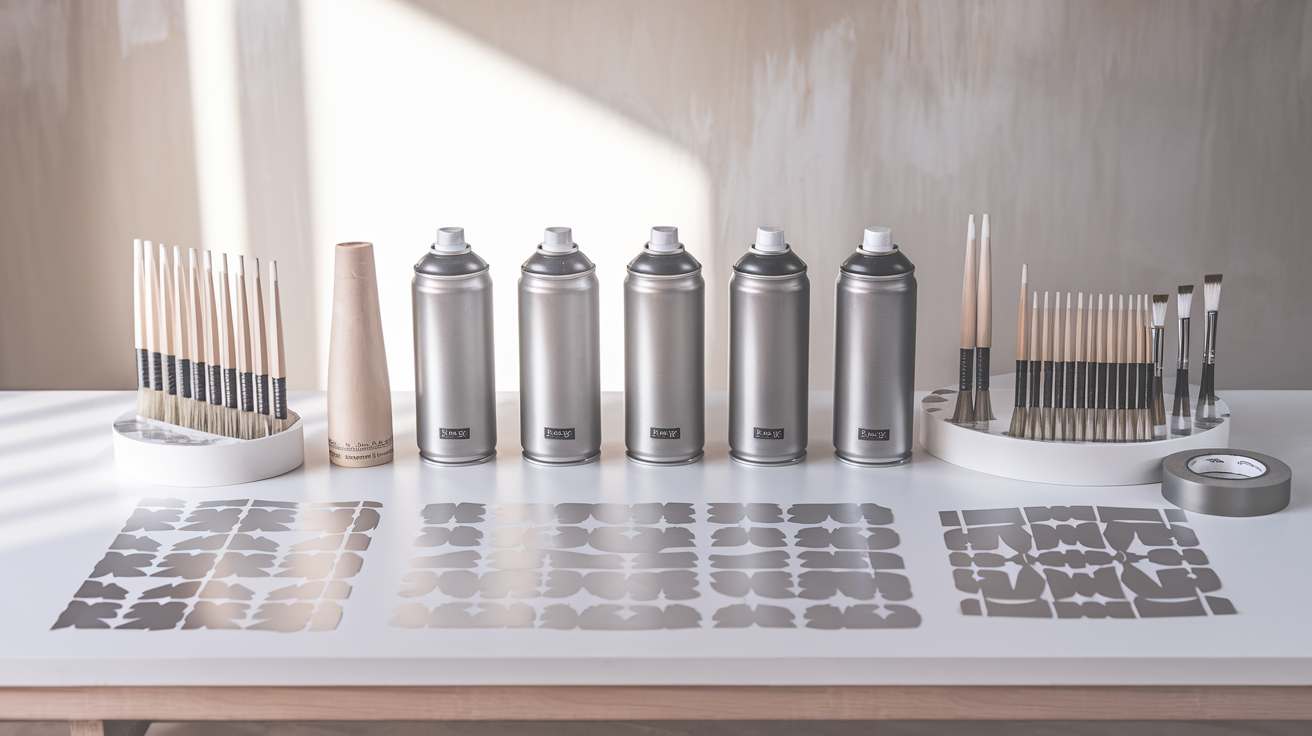Essential Supplies For Professional Stenciling Projects

For professional stenciling projects, the right essential supplies are key to achieving crisp stencil edges and detailed patterns. Precision application tools like stencil brushes, foam rollers, and daubers provide control for consistent coverage.
Quality stencils, such as durable Mylar stencils, promote sharp lines and reliable performance, while painter’s tape or spray adhesive ensure stencil securing and paint bleed prevention.
Paint trays and offloading tools aid in managing paint, crucial for preventing fuzzy edges or uneven color for flawless designs.
Proper brush storage and stencil cleaning extend the life of your crafting toolkit, benefiting both beginner stenciling enthusiasts and experienced crafters.
- Previous:
- Current:
- Next: Choosing the right stencil brushes
Choosing the Right Stencil Brushes
Selecting the correct stencil brushes is fundamental for precision application and achieving crisp stencil edges. Firm brush tips are essential for beginner stenciling techniques, helping with paint bleed prevention and minimizing paint lifting. For experienced crafters, synthetic bristles offer flawless designs with acrylic paint, preventing splaying and ensuring consistent coverage. Flat brushes excel at broad strokes for patterned borders, delivering repeatable results. Testing your chosen stencil kit on scrap material with proper paint control allows for texture experimentation before tackling detailed patterns, enhancing your results. Combine daubers for varied effects and maintain stencil care for reliable performance.
- Previous:
- Current: Choosing the right stencil brushes
- Next: Selecting Your Paints and Mediums

Selecting Your Paints and Mediums
To achieve vibrant and consistent coverage, the selection of paints is paramount. For crisp lines and minimal paint bleed, consider using acrylic paint, chalk paint, or specialized stencil cremes, as these offer excellent color and are less prone to seeping under stencil edges. Paint control begins with proper paint application; use a paint tray or palette for holding your paint and offloading tools like rags or paper towels to remove excess. This prevents fuzzy edges and uneven color, ensuring sharp lines. For beginners, mastering the technique of offloading paint is a significant step towards repeatable results.
- Previous: Choosing the right stencil brushes
- Current: Selecting Your Paints and Mediums
- Next: Securing Your Stencils
Securing Your Stencils
To prevent shifting stencils and ensure sharp lines, proper stencil securing is non-negotiable. Painter’s tape or a repositionable spray adhesive are excellent options for keeping stencils firmly in place, crucial for paint bleed prevention. This helps maintain consistent coverage across your design, whether you are using Mylar stencils, vinyl stencils, or polystyrene stencils. Proper stencil placement, combined with good adhesive, guarantees crisp stencil edges and detailed patterns. For your crafting toolkit, reliable stencil adhesives contribute significantly to smudge prevention and overall reliable performance for flawless designs.
- Previous: Selecting Your Paints and Mediums
- Current: Securing Your Stencils
- Next: Essential Tools for Precision and Alignment
Essential Tools for Precision and Alignment
Achieving flawless designs requires tools that aid in precision application and perfect alignment. Rulers and alignment tools help ensure straight placement for patterned borders and repeatable results, especially when working with detailed patterns. Using a stencil kit with these accessories makes DIY stenciling more manageable. Proper alignment also contributes to preventing fuzzy edges and ensuring consistent coverage with your chosen stencil materials. For beginners, these tools simplify the process, leading to more professional stenciling projects.
- Previous: Securing Your Stencils
- Current: Essential Tools for Precision and Alignment
- Next: Stencil Care and Maintenance
Stencil Care and Maintenance
Extending the lifespan of your quality stencils and stencil brushes is key to reliable performance. Stencil cleaning is essential after each use; mild soap and water are often sufficient for removing paint lifting and preventing smudging. Proper brush storage ensures your stencil brushes maintain their shape and effectiveness for future projects. For your crafting toolkit, durable stencils and well-maintained brushes are investments that contribute to consistently flawless designs, making both beginner stenciling and advanced techniques more enjoyable and successful.
- Previous: Essential Tools for Precision and Alignment
- Current: Stencil Care and Maintenance
- Next:
What are the best stencil brushes?
Quality stencil brushes with dense, stiff bristles stand out as essential supplies for professional stenciling projects, optimizing paint control and delivering crisp stencil edges for flawless designs. Experienced crafters recommend brushes with a small, rounded head to enable precision application when stippling, allowing easy creation of textured effects or detailed patterns.
Selecting stenciling tools with comfortable, ergonomic handles reduces fatigue for lengthy sessions and repeatable results.
Stiffer bristles offer excellent resistance against stencil edges, limiting paint bleed and helping with sharp lines, while natural or synthetic options suit different media.
Adding a dedicated brush to your crafting toolkit ensures reliable performance with every project.
Brush Bristle Density and Shape
Stiffer bristles offer more control against stencil edges. A small, rounded brush can be useful for stippling techniques.
Look for brushes with comfortable handles for extended use, supporting precision application. The right stencil brushes are key for smooth application.
Choosing the Right Stenciling Tools
Beyond brushes, various stenciling tools contribute to success.
Foam rollers offer even coverage for larger areas.
Daubers are excellent for quick application and adding texture.
Proper selection of these stencil materials aids in achieving consistent coverage.
Mastering paint bleed prevention
Paint bleed prevention begins by firmly securing quality stencils to your working surface using painter’s tape or stencil adhesive spray, which ensures flawless designs and smudging prevention during application. Stencil adhesives help keep shifting stencils in place, particularly on intricate patterns or challenging surfaces.
Employing a dry brush technique—with excess paint lifted onto offloading tools such as rags or paper towels—reduces the risk of paint seeping beneath Mylar stencils or vinyl stencils. Precision application using light, stippling motions and minimal paint volume gives consistently sharp lines, enhancing your DIY stenciling results and textured effects while maintaining repeatable results for all beginner stenciling and experienced crafters.
Securing Your Stencils
Ensure stencils are firmly adhered before applying paint.
This step is essential for preventing fuzzy edges and uneven color.
Consider using a spray adhesive for a more secure stencil hold, especially with delicate or patterned borders.
Paint Application Techniques
Use a dry brush technique, lifting excess paint from the brush onto offloading tools.
This method reduces the risk of paint seeping under the stencil. For best results with acrylic paint or chalk paint, apply paint in light, tapping motions.
Advanced Stenciling Tips
Utilize alignment tools or rulers to ensure perfect stencil placement.
Experiment with color layering and texture experimentation using various stencil cremes or paints. Proper stencil care and stencil cleaning are key for durable stencils and reliable performance.
Key Stenciling Insights
- Stencil brushes with dense, stiff bristles are recommended for precise paint control and crisp stencil edges.
- A dry brush technique, using offloading tools to remove excess paint, is crucial for preventing paint bleed.
- Securing stencils firmly with painter’s tape or stencil adhesive spray is essential for flawless designs and smudge prevention.
- Foam rollers and daubers are alternative stenciling tools that offer even coverage for larger areas and quick texture application, respectively.
How to Achieve Crisp Stencil Edges?
Achieving crisp stencil edges requires careful attention to your chosen tools and application techniques, ensuring sharp lines and preventing fuzzy appearance. Stencil brushes with dense bristles offer superior control, preventing paint from seeping beneath the stencil for precise application.
Quality stenciling tools like daubers and foam rollers can also aid in minimizing bleed, but avoid broad brush strokes that encourage paint buildup.
For effective paint bleed prevention, apply paint in light, even coats using a gentle tapping motion, especially around the stencil’s perimeter.
To manage excess paint, utilize offloading tools, such as a paint tray or paper towels, to remove any surplus before touching the project surface; controlled paint application ensures consistent coverage. Once your detailed patterns are complete, peel away the stencil slowly and at an angle once the acrylic paint is touch-dry, preserving your flawless designs.
Mastering your brush technique is only one element; securing the stencil effectively is equally important for repeatable results.
Essential Painters Tape for Stencils
Low-tack painters tape serves as a fundamental stenciling supply for achieving sharp lines without damaging your project surface, making it ideal for DIY stenciling. Proper stencil placement begins with applying the tape flush to the stencil edge, creating a reliable seal that enhances consistent coverage.
For intricate areas requiring extra security, consider a stencil adhesive spray to keep the stencil firmly in place, supporting edges for repeatable results.
Effective paint control with tape involves smoothing overlapping sections to avoid raised paint lines and potential uneven color.
Applying painters tape flush to edges prevents paint seepage, contributing to crisp stencil edges and flawless designs in every project. With the stencil securely affixed, the final element contributing to pristine lines is the selection of quality stencil materials.
- Using stencil brushes with dense bristles helps prevent paint from seeping beneath the stencil for precise application.
- Applying paint in light, even coats with a gentle tapping motion, particularly around the stencil’s perimeter, is key for effective paint bleed prevention.
- Securing the stencil effectively by applying painters tape flush to the stencil edge creates a reliable seal that enhances consistent coverage.
- Peeling away the stencil slowly and at an angle once the acrylic paint is touch-dry helps preserve flawless designs.
What Spray Adhesive is Used For
Professional stenciling projects demand precise stencil placement and effective paint bleed prevention, making spray adhesive a valuable tool in your crafting kit. Beyond painter’s tape, stencil adhesives deliver even, reliable adhesion across the entire stencil, ensuring every edge remains firmly sealed against the surface.
By misting a light, even coat on the back of your stencil and waiting until it feels tacky, you create a barrier that minimizes shifting stencils and eliminates fuzzy edges.
This process is especially important for detailed patterns or when using acrylic paint, as a secure stencil prevents smudging prevention and helps achieve crisp stencil edges with every application.
Transitioning from stencil adhesives, it’s important to consider the quality of the stencil material itself for long-lasting, sharp results that contribute to flawless designs.
Selecting Quality Mylar Stencils
Successful DIY stenciling is shaped by not only the tools and adhesive but also by choosing durable, flexible Mylar stencils designed for repeatable results.
Unlike standard stencil materials, Mylar resists tearing and warping, ensuring reliable performance—even during textured effects or color layering. High-quality stencils feature sharply cut edges for flawless designs and crisp stencil edges, reducing the risk of uneven color or paint lifting.
Thicker Mylar offers a superior seal for paint bleed prevention, making it a smart investment for both beginner stenciling projects and experienced crafters seeking sharp lines and consistent coverage with each use.
Beyond brush and tape, the stencil material itself matters for achieving sharp lines and consistent coverage.
Mylar stencils offer durability and flexibility, resisting tears and warping for reliable performance on your projects. Always check for clean-cut edges on the stencil design itself, as this directly impacts the sharpness of your final result.
Thicker Mylar can provide a better seal against the surface, contributing to effective paint bleed prevention and reducing the likelihood of fuzzy edges.
Stencil Application Tips
- For precise application, use stencil brushes, foam rollers, or daubers.
- Apply paint in light layers to ensure consistent coverage and prevent bleed under the stencil.
- When using chalk paint or stencil cremes, offload excess paint onto a paint tray or paper towel using offloading tools.
Maintaining Your Stencils
- Proper stencil care, including stencil cleaning with mild soap and water, extends their lifespan for repeatable results.
- Store durable stencils properly to prevent damage and maintain their shape for future use.
Investing in a basic stenciling toolkit with quality stencils, appropriate paints like acrylic paint, and reliable adhesives such as spray adhesive or painter’s tape will streamline your workflow and produce consistently flawless designs.
- Spray adhesive provides even, reliable adhesion across the entire stencil, ensuring edges remain sealed and minimizing shifting stencils and fuzzy edges.
- Mylar stencils resist tearing and warping, ensuring reliable performance and contributing to flawless designs and crisp stencil edges.
- Thicker Mylar offers a superior seal for paint bleed prevention, which is beneficial for both beginner and experienced crafters seeking sharp lines and consistent coverage.
- Proper stencil care, including cleaning with mild soap and water, extends the lifespan of durable stencils for repeatable results.
Why use stencil adhesives?
Securing Your Stencils for Flawless Designs
Stencil adhesives offer a significant advantage when aiming for crisp stencil edges and paint bleed prevention. These adhesives are key to stencil securing, effectively locking the stencil in place without the need for excessive painter’s tape, which is particularly beneficial for complex or curved surfaces.
The correct stencil placement is paramount for achieving sharp lines and consistent coverage, making repositionable adhesives a valuable addition to any crafting toolkit.
For beginner stenciling, using these products ensures a more forgiving process, reducing the frustration of shifting stencils and the resulting fuzzy edges or uneven color.
Experienced crafters also rely on these for the precision application required for intricate patterns and detailed designs, ensuring repeatable results and reliable performance. When you’re working with Mylar stencils or vinyl stencils, the right adhesive prevents movement that can lead to smudging prevention and inconsistent color application.
Investing in a good stencil kit often includes or recommends the use of these essential items, contributing to an overall smoother and more professional DIY stenciling experience.
Benefits of Repositionable Adhesives
Choosing products that are repositionable offers greater flexibility for easier stencil placement and adjustments, especially when dealing with textured effects or intricate patterned borders.
This ease of use is a significant factor in achieving flawless designs with quality stencils.
When learning DIY stenciling, the ability to reposition a stencil can save considerable time and reduce material waste, ensuring better paint control.
This aspect is also important for color layering, where precise alignment between coats is necessary. While chalk paint and stencil cremes offer unique finishes, the underlying stencil adhesion is what guarantees the clean outcome.
The stencil care and maintenance of durable stencils are enhanced when the initial application is secure and easily managed. For those exploring different media, like acrylic paint, the adhesive ensures that the paint doesn’t seep under the stencil, maintaining the intended look.
Stencil adhesives provide reliable performance by adhering your chosen stencil firmly to the surface.
This stencil securing is essential for preventing unwanted movement, which can lead to issues like paint lifting, smudging, and uneven color distribution, especially when using stencil brushes, foam rollers, or daubers.
They are indispensable for achieving crisp stencil edges and sharp lines, making them a vital component in any stenciling tools collection for both beginner stenciling and advanced techniques. The ability to easily reposition the stencil is a major benefit, streamlining the often intricate process of stencil placement and contributing to repeatable results.
For crafters using Mylar stencils or vinyl stencils, these adhesives ensure the stencil remains stable, leading to cleaner applications and a reduction in common stenciling problems like fuzzy edges. Ensuring proper paint control and offloading paint onto appropriate tools like paper towels or rags further aids in preventing paint bleed.
The overall goal is to achieve professional-looking finishes with consistent coverage and minimal effort.
Always secure the stencil before painting, using tape or adhesive for best alignment and sharpness.
Rotate between brushes, rollers, and sponges to experiment with texture and color layering.
Proper care and storage of stencils and brushes extend their lifespan and ensure reliable performance on future projects.
Invest in a basic stenciling toolkit to streamline your workflow and produce consistently flawless designs.
Use only a minimal amount of paint to achieve clean edges and prevent bleeding under the stencil.
Always secure the stencil before painting, using tape or adhesive for best alignment and sharpness.
Proper stencil securing is paramount for
- Stencil adhesives prevent paint bleed and shifting stencils, which is crucial for achieving crisp stencil edges and sharp lines.
- Repositionable adhesives offer flexibility for easier stencil placement and adjustments, saving time and reducing material waste, especially for textured effects or color layering.
- These adhesives ensure stencils remain stable on surfaces like Mylar or vinyl, leading to cleaner paint applications and preventing issues like fuzzy edges or smudging.
- Using stencil adhesives contributes to consistent coverage and professional-looking finishes, making them a valuable addition to any crafting toolkit for both beginners and experienced crafters.




